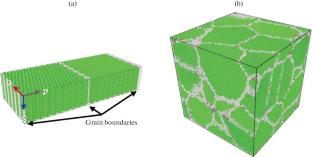镍晶界自扩散的原子模拟
IF 0.48
Q4 Physics and Astronomy
Bulletin of the Russian Academy of Sciences: Physics
Pub Date : 2024-10-14
DOI:10.1134/S1062873824707566
引用次数: 0
摘要
采用原子模拟方法计算了镍中对称倾斜晶界和一般类型晶界的自扩散系数。特殊倾斜晶界采用双晶模型模拟,一般类型晶界则采用纳米晶模型模拟。自扩散系数与温度有关。确定了自扩散的活化能。本文章由计算机程序翻译,如有差异,请以英文原文为准。

Atomistic Simulation of Self-Diffusion in Nickel Grain Boundaries
The self-diffusion coefficients for symmetrical tilt grain boundaries and for grain boundaries of the general type in nickel were calculated by atomistic simulation methods. The special tilt grain boundaries were simulated using a bicrystal model; and general-type grain boundaries, in a nanocrystal model. The self-diffusion coefficient was represented as a temperature dependence. The activation energies of self-diffusion were determined.
求助全文
通过发布文献求助,成功后即可免费获取论文全文。
去求助
来源期刊

Bulletin of the Russian Academy of Sciences: Physics
Physics and Astronomy-Physics and Astronomy (all)
CiteScore
0.90
自引率
0.00%
发文量
251
期刊介绍:
Bulletin of the Russian Academy of Sciences: Physics is an international peer reviewed journal published with the participation of the Russian Academy of Sciences. It presents full-text articles (regular, letters to the editor, reviews) with the most recent results in miscellaneous fields of physics and astronomy: nuclear physics, cosmic rays, condensed matter physics, plasma physics, optics and photonics, nanotechnologies, solar and astrophysics, physical applications in material sciences, life sciences, etc. Bulletin of the Russian Academy of Sciences: Physics focuses on the most relevant multidisciplinary topics in natural sciences, both fundamental and applied. Manuscripts can be submitted in Russian and English languages and are subject to peer review. Accepted articles are usually combined in thematic issues on certain topics according to the journal editorial policy. Authors featured in the journal represent renowned scientific laboratories and institutes from different countries, including large international collaborations. There are globally recognized researchers among the authors: Nobel laureates and recipients of other awards, and members of national academies of sciences and international scientific societies.
 求助内容:
求助内容: 应助结果提醒方式:
应助结果提醒方式:


